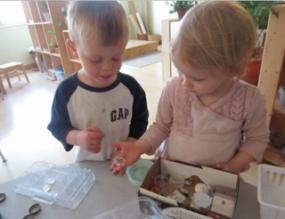Sorting by Size

In this video clip, Kaia and Lincoln agree to begin sorting a collection of donated materials by separating out the glass pebbles, which the children refer to as marbles. The children initially have different ideas about how to sort the pebbles. Kaia works to establish one-to-one correspondence by placing one pebble per compartment in the tray. Alternately, Lincoln wants to group the similarly sized pebbles together in a single large compartment in the tray. Kaia selects a clear heart from the assorted materials (01:02). Although the heart and pebbles have a shared attribute (clear), Lincoln uses the criteria of shape to sort the objects. He says, “That one goes - I think hearts can go in the bottom” (01:05). Kaia retrieves a small clear pebble and Lincoln says, “And that’s small, so this one can go there,” as he adds it to the large compartment with similarly sized pebbles. The next four pebbles are nearly identical, and Lincoln continues sorting them in the same manner (01:15 – 01:30). Kaia also adopts this sorting rule as she sifts through the box, retrieving similar items. The next pebble is slightly larger, and Lincoln pauses to examine it (01:36) before deciding to sort it along with the other pebbles. Lincoln extends his comparison of objects on the basis of size by relating a small dark pebble to a beverage container lid. Believing it will fit, he works to push the pebble through the opening (01:56-02:01). Although the pebble has a different attribute (dark color), Lincoln puts it in the same bin as the clear pebbled. Did the container lid distract him or does he add the dark pebble to the clear ones because it is the same size? The coordination of similarity and difference is central to the child’s later understanding of number concepts (conservation of quantity). Note that Lincoln has a bin with large pebbles, so in placing the dark pebble he is doing more than just putting all pebbles in a common bin. The collection of materials is uniform enough for the children to define a sorting rule and classify objects (small, pebble), but varied enough to encourage the children to discriminate differences and reflect on what features to accept or ignore. Kaia selects a seashell, and Lincoln rejects it by saying, “This isn’t a marble” (02:15). This rejection indicates that Lincoln may be working to sort along two attributes: size (large and small) and class (seashell and pebble). Kaia sorts the seashell into a separate compartment (02:23). Lincoln assumes the size of the object guides her decision. Lincoln articulates a new sorting rule stating, “These ones are big,” and places two clear cylindrical containers into two separate compartments in the tray (03:15, 03:25). Kaia continues discriminating a single attribute (size) along which to group objects. She picks up small foam animals and says, “Look at all these, Lincoln. These are in the middle (location),” as she sorts the animals into the large compartment together with the small pebbles (03:07). Lincoln’s continued actions suggest that he has progressed to sorting objects along two attributes. He places a metal bottle cap into a single compartment (03:00); then removes the metal bottle cap, as if reflecting on his decision, before returning it to the same compartment as he says, “Right there” (03:03). Lincoln then picks up two more bottle caps and sorts them into the same compartment along with the first (03:06). The children successfully differentiate small and large objects. In what ways might you encourage them to sort medium objects, and thereby consider the two-way relationship between objects that are smaller than “large” and bigger than “small”? What could you do to invite the children to add additional attributes to their sorting rules (small heavy circle)?
Keywords: threes, child-object, assorted materials, math, relationships, sorting, one-to-one correspondence
Lenght of video: 4 minutes 9 seconds
